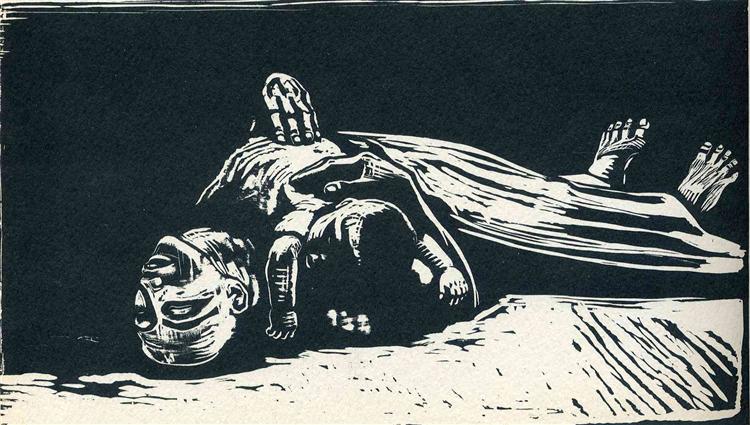Description
Käthe Kollwitz, one of the most prominent figures of expressionism and socially committed art, offers us in his work "The Widow II" (1922) a deep reflection on pain and loss. This painting, which is part of its series dedicated to widowhood, encapsulates the emotional state of women who have experienced the devastating reality of war and death. In the work, Kollwitz uses an approach that combines an expressionist technique with overwhelmingly human content, managing to convey with intense clarity the suffering of its subject.
The composition of "The Widow II" reveals a central figure of a woman who, in a gesture of despair, clings to the head of a child, a tangible symbol of her sadness and the burden of mourning. The woman, with her dark hair and her face marked by contradiction, is an emblematic portrait of mourning motherhood, a figure that represents not only her own duel, but the collective suffering of many others. The expression of the woman, at the same time desolate and resigned, evokes a palpable vulnerability, an echo of the social and political tensions of the time that Kollwitz captured throughout her career. The relationship between mother and child is intense and symbolic, a reflection of the losses and hope that intertwines in the life of those who suffer.
The use of color in this work is significant; The predominance of dark and off tones highlights the gloomy and melancholic atmosphere. Kollwitz, through his palette, establishes a dialogue between the light and the shadow that accentuates the tragedy of the central figure. Each line seems loaded with emotion, from the diffuse background that suggests an empty environment to the defined contours of the mother and the child, creating a contrast that highlights personal suffering against the indifference of the world.
In addition to its emotional content, "Widow II" is part of a broader context of Kollwitz's work. His art often addresses issues of human suffering, inequality and the struggle of oppressed. His works are recognizable not only for their technical quality, but also for their deep empathy towards human beings, particularly working classes and women. The artist, witness to the horrors of World War I and the social difficulties of her time, used her talent to give voice to those who were often silenced.
Kollwitz's work is presented as a timeless reflection on the human experience of duel. "The widow II", in particular, connects with others paintings of the series of the widow that the artist created in response to the pain she observed around her. These works share a sense of urgency, a call to awareness about the impact of war on people's lives.
In summary, "The Widow II" is a powerful work that transcends individual suffering to talk about a universal human experience. With his ability to capture anguish and despair with heartbreaking sincerity, Käthe Kollwitz converts this painting into a moving testimony of human vulnerability to unavoidable adversities. His legacy lasts, reminding us that art is not only an aesthetic representation, but also a form of resistance and a vehicle for compassion.
KUADROS ©, a famous paint on your wall.
Hand-made oil painting reproductions, with the quality of professional artists and the distinctive seal of KUADROS ©.
Art reproduction service with satisfaction guarantee. If you are not completely satisfied with the replica of your painting, we refund your money 100%.

